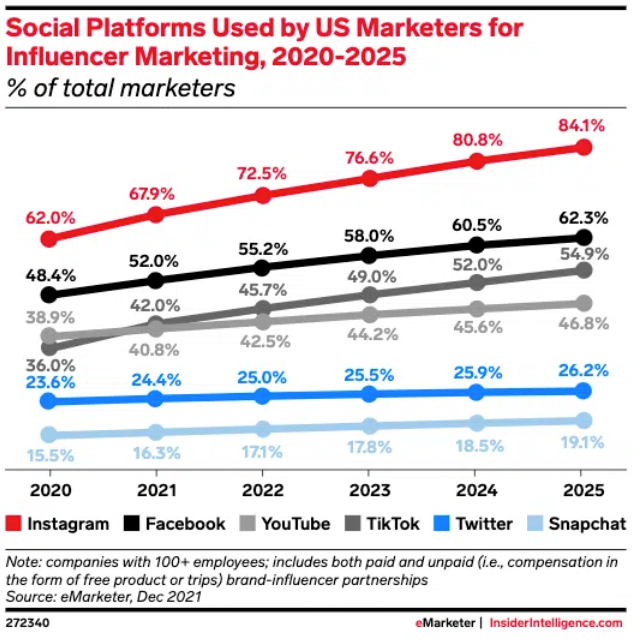Influencer marketing in your social media strategy can be a valuable approach. But what exactly is influencer marketing? It involves businesses teaming up with individuals who possess a substantial presence on social media platforms to promote their products and services.
In the present day, a vast number of people regularly use social media, making it a prime avenue for reaching a wide audience. People tend to place trust in the content creators they follow, making it a smart move for businesses to connect with social media influencers who have bigger followings and better engagement rates.
Through these collaborations, businesses can gain significant exposure for their products and services, leading to increased conversion rates. To make the most of influencer marketing campaigns, it’s crucial to have a well-defined strategy in place.
Before developing a robust social media influencer marketing strategy, let’s begin with the basics, including what it entails, how it operates, and whether it fits your organization.
Understand What Exactly is Influencer Marketing

In its most basic form, an influencer is someone with the ability to sway others’ opinions and choices. In influencer marketing, a subset of social media marketing, brands compensate these influential individuals to endorse their products or services to their followers. So, what is influencer marketing? It is a strategy where brands partner with influencers to advertise products and services to the influencer’s audience through sponsored content.
A significant 72.5% of marketers in the United States are expected to incorporate influencer marketing into their strategies this year, and this trend is on a steady rise.
If you’re still skeptical about the impact of influencer marketing on tangible business outcomes, consider this: Civic Science’s research revealed that 14% of individuals aged 18 to 24 and 11% of millennials made purchases in the past six months based on recommendations from bloggers or influencers.
At present, Instagram continues to be the preferred platform for social influencers. Based on eMarketer’s projections, 76.6% of U.S. marketers are set to leverage Instagram for their influencer initiatives in 2023. However, it’s wise to keep a watchful eye on TikTok, as it’s an emerging player in this arena.

Difference Between Influencer Marketing and Celebrity Endorsements
| Aspect | Influencer Marketing | Celebrity Endorsements |
| Audience Reach | Niche and engaged followers | Broad and diverse fan base |
| Relatability | Perceived as peers | It may feel less relatable |
| Niche vs. Mass Appeal | Effective for specific segments | Effective for broad audiences |
| Authenticity and Credibility | Valued for authenticity | It may appear less authentic |
| Cost and Accessibility | Cost-effective, accessible | Often more expensive |
| Social Media Platforms | Emphasis on digital platforms | This may extend to traditional media |
Types of Influencer
There are five distinct categories, each based on their follower count:
- Nano influencers have less than 10,000 followers.
- Micro-influencers fall within the range of 10,000 to 50,000 followers.
- Medium influencers have a follower count ranging from 50,000 to 100,000.
- Macro influencers boast over 500,000 followers.
- Mega influencers reside in a league with a staggering one million or more followers.
While it might be tempting to believe that brands exclusively seek out macro influencers, that’s not always the wisest business choice. Micro-influencers often offer a unique advantage by producing more relatable content than their macro counterparts.
Macro influencers often employ professionals, including photographers, stylists, makeup artists, and consultants, to craft their posts. This can create an image of a lifestyle that feels unattainable to many. In contrast, micro-influencers have a knack for connecting with their followers by embodying a sense of accessibility that resonates with a broader audience.
What Factors Contribute to a Winning Influencer Marketing Campaign?

Achieving success in an influencer marketing campaign depends on several factors:
- Strategic Alignment: Ensuring the influencer’s content and audience align closely with your brand’s message and target demographic is paramount. A strategic fit minimizes dissonance and maximizes the effectiveness of the campaign.
- Creative Collaboration: Collaborating with influencers in a way that allows them to maintain their unique voice and style while incorporating your brand’s message is essential. Striking the right balance between creativity and brand messaging can be a key success factor.
- Authenticity and Credibility: Influencers must maintain their authenticity and credibility with their audience. Campaigns that feel genuine and resonate with the influencer’s brand tend to perform better.
- Audience Engagement: Consider not only the size of an influencer’s following but also the level of engagement they have with their audience. High engagement rates often lead to more meaningful interactions and higher conversion rates.
- Clear Objectives: Define the goals and objectives of the campaign. Whether driving sales, increasing brand awareness, or boosting website traffic, having well-defined metrics helps track success.
- Measurement and Analysis: Implement effective tracking and analytics to evaluate the campaign’s performance. Analyzing data allows for course corrections and improvements along the way.
- Long-Term Relationships: Building enduring relationships with influencers can lead to more authentic and successful campaigns. Long-term partnerships often result in deeper connections with the audience.
How will the metaverse influence the dynamics of influencer marketing?
The metaverse, a relatively new and intricate concept, is often described as an evolution of the internet. It’s a burgeoning 3-D digital realm that enables people to engage in immersive experiences through virtual reality and other cutting-edge technologies. Within the metaverse, individuals interact with peers, content, cryptocurrencies, brands, and various virtual environments.
What lies ahead for marketing within the metaverse? The intriguing revelation is that people are more than willing to invest in virtual goods. The direct-to-avatar sales of such items have given rise to a thriving $54 billion industry.
Take, for example, Coca-Cola’s collaboration with Tafi, where they crafted virtual wearables for Coca-Cola’s inaugural non-fungible token (NFT) collectibles in the metaverse, commemorating International Friendship Day. Coca-Cola conducted an auction on OpenSea, featuring an NFT loot box containing digital attire that can be sported within the virtual realm of Decentraland.
Additionally, Nike has delved into the market by offering virtual sneakers known as Nike Cryptokicks. This intriguing intersection of brands and the metaverse underscores the evolving marketing landscape in this digital frontier.
Advantages of Influencer Marketing
Cost-Effective
Influencer marketing is a cost-effective business strategy. Instead of allocating large budgets to traditional advertising, partnering with influencers can often yield better results at a lower cost. Influencers are adept at creating engaging content that resonates with their audience, making it a cost-efficient way to reach a target market.
Excellent for Social Spreading
Influencer marketing is a mighty sword for expanding a brand’s social media presence. Influencers have already cultivated a dedicated following, and their endorsement can significantly boost a brand’s visibility. Their content is often shared and liked by their followers, extending the reach of the brand’s message across various social platforms.
Facilitating Diverse Messaging
Influencers operate in diverse niches and have a wide range of expertise. This diversity allows brands to collaborate with influencers who align with their specific target audience and messaging. Whether it’s in the realm of fashion, technology, or wellness, influencers offer a versatile platform for tailored and niche-specific communication.
Cutting Through the Noise
In an era of information overload, it’s challenging for brands to capture the attention of their specific audience. Influencers can serve as a bridge between brands and consumers, providing a more focused and authentic message that stands out amidst the noise of traditional advertising. They help filter through the clutter to reach a receptive audience.
Starting a Snowball Effect
Influencer marketing has the certainty to create a snowball effect in terms of engagement and brand recognition. Influencers introduce a brand to their followers, and when those followers become brand advocates, the message gains momentum. Positive experiences and recommendations from influencers can lead to word-of-mouth marketing and a self-perpetuating cycle of engagement and conversions.
The Challenges of Influencer Marketing

Influencer marketing, while a powerful strategy, comes with challenges that brands must navigate successfully.
Limited Margin for Error
In influencer marketing, there is minimal tolerance for mistakes. Since influencers often serve as a direct link between a brand and its target audience, any errors in messaging, brand alignment, or execution can have an important impact on the brand’s reputation and campaign outcomes. Careful planning and oversight are necessary to avoid missteps.
Crucial Importance of Influencer Selection
Choosing the right influencers is a critical aspect of a successful influencer marketing campaign. Brands must be meticulous in selecting, ensuring that the influencer’s values, content, and audience align closely with the brand’s identity and target demographic. An incorrect choice can lead to a campaign that lacks authenticity.
Complexity of Analytics
Analyzing the impact and effectiveness of influencer marketing campaigns can be challenging. Metrics and analytics may not always provide straightforward answers. Brands must grapple with various data sources and metrics, often from different platforms and influencers, to gauge the campaign’s success accurately. The complexity of data analysis can make it confusing and time-consuming to extract actionable insights.
Conclusion
Influencer marketing is a multifaceted strategy that capitalizes on the persuasive power of social media personalities to engage targeted audiences genuinely and cost-effectively. While it offers compelling advantages, including the potential for social spreading and diverse messaging, it requires meticulous influencer selection, strategic alignment, and complex data analysis to navigate its challenges successfully.
In essence, what is influencer marketing involves leveraging individuals with influence over potential buyers to promote products or services through sponsored content. The emerging metaverse introduces fresh opportunities for influencer marketing, signifying a shift in consumer behavior.
FAQs
What is influencer marketing?
It is a digital marketing strategy in which brands collaborate with individuals, known as influencers, who have a substantial presence and following on social media platforms.
Why is influencer marketing effective?
Influencer marketing is highly effective because it leverages the trust and authority that influencers have developed with their followers. Audiences often view influencers as authentic and relatable, making their endorsements more persuasive than traditional advertising.
Who are influencers, and what makes them influential?
Influencers can be anyone, from celebrities and experts in a particular field to everyday individuals who have obtained a large following on social media platforms. They are considered influential due to their ability to shape opinions, trends, and purchasing decisions among their followers.
What are the different types of influencers?
Influencers come in various sizes, including nano (fewer than 10,000 followers), micro (10,000 to 50,000 followers), medium (50,000 to 100,000 followers), macro (more than 500,000 followers), and mega (over one million followers). Each category offers different advantages for brands.





